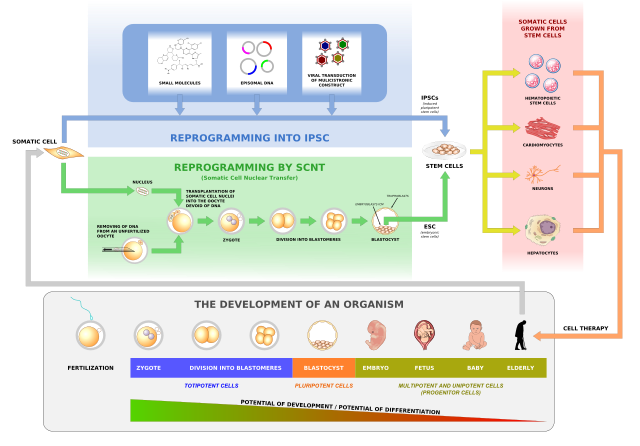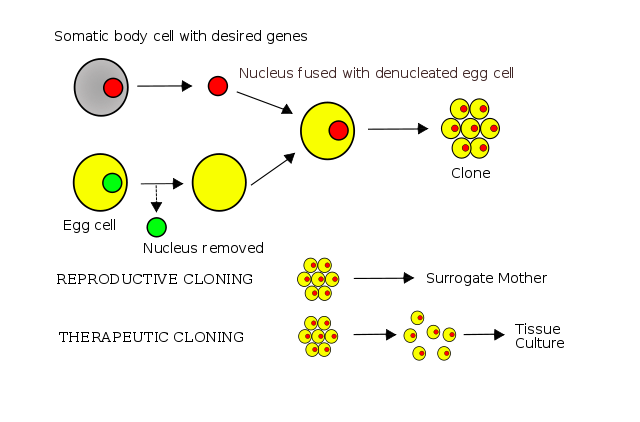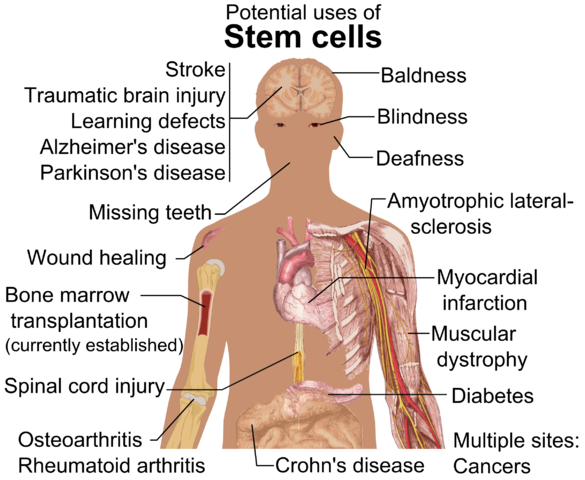DNA TECHNOLOGY: Whole Organism Cloning and the Ethical Problems Surrounding it.
Cloning is a difficult topic for anyone; it is
not only complex biology, but it is also a tricky subject ethically, What you feel
about cloning may not just depend on your knowledge of science – it may also
depend on your religious, moral or other views. I will give a brief
introduction here.
CLONING WHOLE ORGANISMS
In 1997, when scientists succeeded in cloning a sheep, there was a lot of fuss in the media. Was it ethically and morally right to clone animals as advanced as mammals? Would this lead to scientists attempting to clone humans?
The definition of a clone is ‘a genetically identical copy’ and the term can apply to individual strands of DNA, individual cells or whole organisms. Cloning is, in fact, a common natural process: all organisms made by asexual reproduction are clones of their parent, unless there is a mutation. Even humans make clones – they are more commonly called identical twins.

Diagram of the ways to reprogram cells along with the development of humans. Kaidor, CC BY-SA 3.0
There is much commercial interest in the cloning process because it can produce exact copies of organisms with desirable characteristics. If, for example you have a ‘perfect’ apple tree that produces large amounts of delicious, healthy blemish-free apples, you can clone it rather than risk losing its valuable genotype in the lottery of sexual reproduction.
Eugenics is the application of genetics to improve human characteristics. It is generally frowned upon, since making genetic alterations to select for cosmetic features, such as blonde hair and blue eyes, is medically unnecessary. However, deciding where eugenics ends and germline gene therapy and embryo selection for medical reasons begin is a difficult ethical problem.
Cloning plants is easy, and can be done with relatively little equipment in schools and colleges. Cloning mammals, however, is a lot more difficult but technically feasible. There are two approaches to cloning whole organisms, embryo splitting and nuclear transfer.
Embryo splitting
In embryo splitting, eggs and sperm or fertilised embryos are collected from prize specimens of for examples, cattle. Cells can be pulled apart when the embryo is at the 8-cell or 16-cell stage and each fragment can then develop into a complete embryo. Each embryo is a clone of the original animal, The process can be repeated many times and then the cloned embryos can be introduced into the uterus of normal cows. After the normal gestation period, several very average animals give birth to a herd of prize specimens.
Nuclear transfer
Cloning is based on nuclear transfer, the same technique that scientists have used for some years to copy animals from embryonic cells. Nuclear transfer involves the use of two cells. The recipient cell is normally an unfertilised egg taken from an animal soon after ovulation. Such eggs are poised to begin developing once they are appropriately stimulated. The donor cell is the one to be copied. A researcher using a high-power microscope holds the recipient egg cell by suction on the end of a fine pipette and uses an extremely fine micropipette to suck out the chromosomes, sausage-shaped bodies that incorporate the cell’s DNA. (At this stage, chromosomes are not enclosed in a distinct nucleus.) Then, typically, the donor cell, complete with its nucleus, is fused with the recipient egg. Some fused cells start to develop like a normal embryo and produce offspring if implanted into the uterus of a surrogate mother.

Diagram of SCNT Process, Belkorin CC BY-SA 3.0
TECHNICAL AND ETHICAL PROBLEMS WITH CLONING ORGANISMS
Dolly the sheep and cc the cat were created by the process of nuclear transfer, a process that many people feel will give rise to cloned humans at some stage in the future. As I have explained in my previous post, the technique sounds simple but we can’t do it reliably. It took over 200 attempts to get Dolly and almost 100 to get cc, the cloned cat. Many laboratories report that only 1 to 2 per cent of cloned embryos survive to become live offspring. Even some clones that survive through birth die shortly afterwards. In 2001, a cloned gaur (an endangered species of wild ox from Asia) lived only a few days before dying from a common dysentery.
This unreliability has two main implications for human cloning that intends to produce living babies. First, each attempt requires an individual egg. Sheep don’t tend to complain when you stimulate their ovaries and harvest the eggs, but humans are a different matter. Very few women will give up eggs for any reason other than their own pregnancy, so finding 200 ova for each attempt Is always going to be a problem. Some women in the USA may have been persuaded to do this by a cult aiming to clone a human, but whether they will actually do so remains to be seen. Secondly, in humans, failure brings great distress. Miscarriages and malformed offspring always cause great distress to all concerned in the process.
In 2001, the UK government passed a law that allowed scientists to produce human embryo clones solely for the purpose of making replacement that could be used in transplant procedures. This was challenged by the pro-life lobby, but in February 2002, a House of Lords Select Committee upheld this decision, and the Human Fertilisation and Embryology Authority, which regulates such research, is now likely to give researchers licences to experiment on early-stage human embryos.
In Australia, the Prohibition of Human Cloning for Reproduction and the Regulation of Human Embryo Research Amendment Act 2006 came into operation on 12 June 2007. The Assisted Human Reproduction Act, which prohibits human cloning, for any purpose, whether for reproductive, therapeutic research purposes was passed in Canada in 2004. Penalties for contravening the prohibition are severe: a maximum fine of $500 000 or ten years in prison, or both. Legislation in the USA has banned all human cloning in the past, but embryo stem cell research is still allowed. Most countries ban human cloning that intends to produce full-term pregnancy, but some unscrupulous scientists can find loopholes and there are repeated stories in the media of cloned babies being born. None have been confirmed.
STEM CELL CLONING
If the objective is not to make a human baby, then why clone? The answer comes down to stem cells. These cells are capable of differentiating into any type of adult body cell. Theoretically, you could say that every cell in the body has the capacity to do this, as they all contain the same genome. However, once a cell has gone through a pathway of differentiation, and has become, say, a brain cell, there is little you can do to shift it back again.
SO, WHAT ARE STEM CELLS?
Stem cells are undifferentiated cells that can turn into any type of body cell, given the right conditions. They have two important properties: They can self-renew. Stem cells can go through unlimited rounds of cell division without differentiating; and they also have unlimited potency – they can differentiate into any body cell type. In reality, not all stem cells have quite unlimited potency. They have different levels of potency, which describe their exact potential for differentiation. This reflects their source.
Totipotent stem cells are the top of the tree – they can differentiate into any type of cell – including the cells that make up an embryo and the cells that develop into the placenta and umbilical cord. Totipotent stem cells are the cells produced just after the egg and sperm cell fuse – only the first few divisions produce totipotent stem cells.
Pluripotent stem cells are the descendants of totipotent cells. They can differentiate into cells from any of the three germ layers of the embyro, but they cannot develop into placenta or umbilical cord tissue.
Multipotent stem cells are partly differentiated but they can differentiate further to produce cells within a closely related family. For example, haematopoietic stem cells can differentiate into the different cell types found in the blood but cannot differentiate into, for example, neurones.
Unipotent stem cells are well differentiated but they can self-renew. They are able to divide to reproduce themselves many times – which makes them different from non-stem cells, which have limited capacity for cell division.

Stem cell treatments. Mikael Häggström, Public Domain
WHAT KINDS OF STEM CELL ARE THERE?
There are three types of stem cell that occur in humans and other mammals:
- Embryonic stem cells. These are all the cells in the early-stage embryo that come directly from blastocysts.
- Adult stem cells. These are a select number of cells in the adult bed that still act as stem cells, for example some cells found in the nasal epithelia in the nose.
- Cord blood stem cells. These are stem cells found in the blood and tissues of the umbilical cord.
WHAT CAN STEM CELLS DO FOR US?
Stem cells hold the key to giving the body what it needs to regenerate healthy tissue. With an ageing population in the developed world, the rate of degenerative disease is increasing massively. Stem cells offer the possibility of replacing neurones in the brain of a stroke victim, or repairing a break in the spinal cord, or repairing the cells of the pancreas so that they can make insulin again.
Studying totipotent human embryonic stem cells is also expected to tell us a lot about how humans develop. How exactly do undifferentiated cells become differentiated? Which genes are turned on and off, when does this happen and what controls it? Understanding this enormously complex process might also help us understand what happens when it goes wrong and cancerous cells divide out of control, losing their differentiated features.
Stem cells might be used to test new drugs – clones of stem cells can be produced that are completely identical – an important requirement for reducing the variables when comparing one drug with another. Stem cells could be used to generate new human tissues and organs for transplantation. At the moment, donated tissues and organs are used but they create the problems of rejection – and demand is well in excess of supply. Stem cells are already being used to grow skin cells in culture to treat burn victims, but it may be possible to renew some of the brain cells that go wrong in Alzheimer’s disease. Maybe one day, stem cell technology and the cloning technology that produces transgenic animals could result in animals with organs that are suitable for human transplantation.
WHY STEM CELLS ARE AN ETHICAL NIGHTMARE
There is a long way to go with ironing out technical problems before many of the potentials of stem cells can be realized. But that is not the only problem. The whole practice of obtaining and using human stem cells is fraught with ethical and moral dilemmas.
The main problem is that most research uses embryonic stem cells, as these are totipotent. The process of removing stem cells from an embryo destroys it – and some people think this is destroying a living human being. Pro-life organisations are opposed to obtaining stem cells from embryos.
Another difficulty is the source of the embryos. Human embryos for research and harvest of stem cells are obtained from three main sources:
- Embryos left over from IVF treatments are used to harvest stem cells. These embryos cannot survive without being transplanted and many more embryos are fertilised than are needed. Ethical problems include obtaining consent of the parents, and checking whether all the embryos are healthy and free from genetic disease.
- Embryos created by in vitro techniques in which donated human eggs are fertilised to create early-stage embryos just to harvest stem cells. As you might expect, the people who think that destroying an embryo is bad think this is even worse. They say scientists are playing God – creating life and then destroying it, for their own gain.
- Even more controversial is the potential practice of human cloning to create embryos. Scientists are able to introduce a body cell into the shell a fertilized egg and get it to divide into a blastocyst. This is technically human clone and is a rich source of human stem cells. But some people argue that this is the slippery slope to cloning humans for reproduction and are completely opposed to it.
FINALLY …
The problem with writing a chapter like this is that it will be out-of-date before the ink is dry at the printers. To keep up, and to find information to help you make up your own mind about cloning, refer to good journals, such as Scientific American and New Scientist (both are available online), and look at the BBC online Science and Technology news site.
SUMMARY
In this post and the previous ones I’ve written on DNA Technology, I made mention the following points:
- Genetic engineers isolate, cut out and transfer genes between organisms. Genetic engineering technology has many applications, including making human products such as insulin on a large scale.
- Strands of DNA are cut using restriction endonuclease enzymes, which always cut DNA at a particular base sequence. Strands of DNA can be joined by using DNA ligase enzymes.
- In order to transfer DNA into a living cell such as a bacterium, a vector (carrier) is needed. Common vectors are plasmids (circles of DNA found in bacteria) and viruses.
- Once the foreign DNA is inside the host cell, it is adopted by the host. Genes in the foreign DNA are expressed using the host cell’s synthetic machinery (ribosomes, mRNA, etc.). In addition, the foreign DNA is cloned (copied) every time the host cell divides.
- The polymerase chain reaction (PCR) allows samples of DNA to be cloned in a test tube using the necessary enzymes, instead of inside a host cell.
- Many recent developments in this field have made cloning whole animals and organs possible. However, although the technical problems have been overcome, the ethical difficulties still pose a great problem for this area of research.
- Gene therapy is a technique that replaces faulty genes with healthy ones. It provides great hope for sufferers of genetic diseases such as cystic fibrosis.
- The Human Genome Project has now produced the complete sequence of all 30 000 genes in the human genome. Knowing this sequence will provide a big boost for research in many areas of biology and medicine.
Thanks for coming.
REFERENCES
https://www.news-medical.net/life-sciences/Organism-Cloning.aspx
https://www.britannica.com/science/cloning
https://knowgenetics.org/cloning/
https://en.wikipedia.org/wiki/Eugenics
https://www.britannica.com/science/embryo-splitting
https://www.sciencedirect.com/science/article/pii/S1110569010000403
http://www.drze.de/in-focus/research-cloning/modules/embryo-splitting?set_language=en
https://en.wikipedia.org/wiki/Nuclear_transfer
https://en.wikipedia.org/wiki/Stem_cell_laws_and_policy_in_the_United_States
https://www.aph.gov.au/Parliamentary_Business/Bills_Legislation/bd/bd0607/07bd059
https://www.legislation.gov.au/Details/C2006A00172
https://en.wikipedia.org/wiki/Human_cloning
https://www.ncbi.nlm.nih.gov/pubmed/16085991
https://www.scientificamerican.com/article/the-ethical-consideration/
https://en.wikipedia.org/wiki/Ethics_of_cloning
https://www.eurostemcell.org/what-cloning-and-what-does-it-have-do-stem-cell-research
Congratulations @loveforlove! You have completed the following achievement on the Steem blockchain and have been rewarded with new badge(s) :
You can view your badges on your Steem Board and compare to others on the Steem Ranking
If you no longer want to receive notifications, reply to this comment with the word
STOPTo support your work, I also upvoted your post!
Hello,
Your post has been manually curated by a @stem.curate curator.
We are dedicated to supporting great content, like yours on the STEMGeeks tribe.
If you like what we are doing, please show your support as well by following our Steem Auto curation trail.
Please join us on discord.
Have you heard about this Chinese researcher who genetically modified human babies? This appeared recently in the news, if I remember well (and this story fits nicely with your post :) )
This post has been voted on by the SteemSTEM curation team and voting trail. It is elligible for support from @curie and @minnowbooster.
If you appreciate the work we are doing, then consider supporting our witness @stem.witness. Additional witness support to the curie witness would be appreciated as well.
For additional information please join us on the SteemSTEM discord and to get to know the rest of the community!
Thanks for having used the steemstem.io app and included @steemstem in the list of beneficiaries of this post. This granted you a stronger support from SteemSTEM.